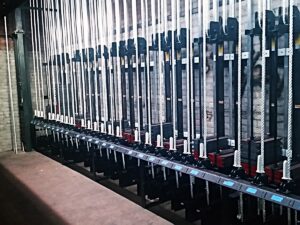
Ensuring the safety and effectiveness of your rigging setup should be a top priority in stage and theatre productions. One of the most critical factors to consider is the weight capacity of your stage rigging equipment. Understanding these limits can prevent dangerous failures, safeguard performers, and maintain the integrity of the entire production. Whether you’re suspending lighting fixtures, props, or set pieces, knowing how much weight your rigging can safely handle is crucial.
Failing to properly account for the weight capacity of theatre rigging equipment can lead to catastrophic accidents, from equipment failure to serious injuries. In this article, we’ll explore what weight capacity means in stage rigging, the factors that affect it, common mistakes, and why professional assessment is essential.
What Are Weight Capacities in Stage & Theatre Rigging?
Weight capacity in stage and theatre rigging refers to the maximum load that the rigging equipment can safely support without risk of failure. Understanding these limits helps ensure that the equipment remains functional and secure during performances.
Here are some key terms related to weight capacities:
- Working Load Limit (WLL): The maximum weight that a piece of rigging equipment can support under normal conditions.
- Maximum Load Capacity: The absolute highest weight the equipment can bear before failing.
- Safety Factor: A ratio used to add an extra margin of safety, typically 5:1 or 10:1 in rigging, to account for unexpected stresses.
Factors That Affect Rigging Weight Capacities
Several factors influence the weight capacities of stage and theatre rigging equipment. Understanding these can help you design a rigging system that is both effective and safe.
- Type of Rigging Equipment: Different equipment types, such as trusses, cables, and hoists, have varying load capacities.
- Materials Used: The strength and durability of the materials in your rigging setup, like steel versus aluminum, can affect load-bearing capabilities.
- Configuration of the Rigging Setup: The way equipment is arranged or distributed across the stage affects the overall load capacity.
- Environmental Conditions: Temperature, humidity, and other environmental factors can weaken materials, reducing their safe working loads.
Common Mistakes in Estimating Weight Capacities
Estimating weight capacities is a precise science, yet it’s easy to make mistakes that can lead to equipment failure or unsafe working conditions. One common error is underestimating the total weight of the load. This can happen when equipment, such as lighting fixtures or set pieces, isn’t weighed accurately, or the rigging crew forgets to factor in additional forces like movement.
Another frequent mistake is ignoring the wear and tear on rigging equipment. Over time, repeated use can degrade the materials, reducing their load-bearing capacity. Failing to account for this degradation can result in equipment that appears safe but is actually at risk of failure. Finally, miscalculating how weight is distributed across the rigging setup can lead to dangerous imbalances, placing excessive strain on certain components.
The Role of Professional Assessment in Determining Weight Capacities
Professional rigging experts ensure the safety of a stage or theatre production. With specialized tools and extensive experience, they can evaluate the rigging equipment and assess its weight capacity based on the specific setup and needs of a production.
These professionals measure and calculate load weights accurately while accounting for all contributing factors, including environmental conditions and the condition of the rigging equipment itself. Their assessments ensure that the rigging setup meets or exceeds industry safety standards, providing peace of mind for production teams.
Real-World Examples of Weight Capacity Failures
Weight capacity failures in stage and theatre rigging are rare but can have severe consequences when they occur. In one notable case, a stage collapsed during a concert because the rigging exceeded its maximum load capacity. The weight of lighting fixtures and speakers, combined with environmental stress from wind, caused the rigging to fail, leading to injuries and property damage.
Another example occurred during a theatre production where a set piece was improperly rigged. The crew underestimated the weight of the set, and the rigging equipment failed, resulting in damage to the stage and a delay in the performance. These incidents highlight the importance of accurately estimating weight capacities and ensuring all equipment is properly maintained.
Conclusion
Understanding and respecting the weight capacities of stage and theatre rigging equipment is essential for any successful production. From accounting for various influencing factors to seeking professional assessments, proper planning can prevent costly failures and keep everyone safe. By avoiding common mistakes and using expert insight, production teams can ensure their rigging setup operates smoothly, allowing the show to go on without incident.